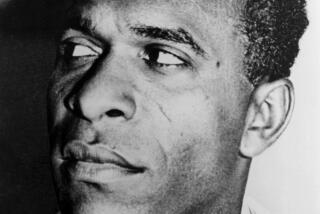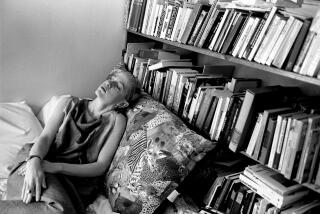How ‘Strange’: The idea appeared, as if by magic
Susanna Clarke had a dream:
She was crossing a square in 18th century Venice and noticed a group of English tourists. One of them, a handsome young man dressed in the latest of styles, stood out -- he had the attitude and posture of a rake, but there was also a softness about him, an inner sensitivity that Clarke found intriguing. She thought something had gone terribly wrong in his life but couldn’t figure out what. Who was he? And what was he doing in Italy?
Clarke had this dream sometime in the late 1980s, when the now 44-year-old author was teaching English in Bilbao, Spain. She initially tried to write a story about the handsome young stranger but realized she didn’t have a plot to go with her vision, so she dropped the idea. Years later, while working as a cookbook editor in Cambridge, England, Clarke, who grew up with a love for such book series as “The Lord of the Rings” and Ursula K. Le Guin’s “Earthsea,” decided to abandon the detective novel she was writing and forge ahead with a work of fantasy, in which one of the main characters would be the elusive young man in her dream.
Ten years down the road and with 782 pages written, she finished “Jonathan Strange and Mr. Norrell,” a mind-bogglingly inventive book about two very different men who attempt to restore the art and craft of magic in 19th century England.
“Magicians have always had a strong pull for me,” says Clarke, a slim, attractive Englishwoman with a full head of beautiful silver hair and a wicked sense of humor. “I like their accouterments of libraries and magic hats. That seems really cute to me.”
“Cute” is the last word one might use to describe “Jonathan Strange and Mr. Norrell.” The book takes place during the Napoleonic wars, when the bookish Mr. Norrell, upset that magic is no longer performed in the British Isles, decides to revive the practice and thereby attracts the attention of his majesty’s government, which uses Norrell’s powers to fight Napoleon.
Norrell soon runs across Jonathan Strange (the man in Clarke’s dream), a neophyte magician who becomes his pupil and eventually outshines him in both charisma and fame. Although the duo have a falling out, they ultimately join forces to fight an evil conjurer known as the Raven King.
Told in a dense, Dickensian style, filled with numerous footnotes about medieval magical practices and references to arcane texts (none of which are real), Clarke’s book has been greeted with generally positive reviews. Comparing it to J.K. Rowling’s “Harry Potter” series, USA Today called the novel “an adult pleasure.” But Entertainment Weekly, while admitting that the work was “intelligent” and “inventive,” also called it “arid and exhausting.”
No matter: The novel must be filling some sort of void because “Jonathan Strange and Mr. Norrell” -- out for just more than a week -- has reached No. 4 on the Los Angeles Times’ bestseller list. And Hollywood has already come calling. Clarke’s agent is reportedly fielding inquiries from New Line, Warners, DreamWorks and Sony.
Clarke is the first to admit that when she started writing she “never intended” for the novel to become such a massive undertaking. “But I’m not sorry that it has,” she says, “because I like long books, and one of the books behind ‘Strange and Mr. Norrell’ is Charles Palliser’s ‘The Quincunx,’ which I’d read in the early ‘90s and just absolutely adored, and that’s 100,000 words longer than this. One of the things I really loved about it is it just has this plot that pulled you through this immense text. But I didn’t think I was capable of writing a book like this.”
In fact, says Clarke, she had a “God, what am I doing?” moment almost every day of the 10-year process. “I only really realized the monumental nature of this as I started to look behind me, at the years piling up. Toward the end I was really having to struggle with the sort of feeling of all these years, and the fact there was still more to go. There was a very genuine dread that it would never be finished.”
But Clarke was lucky in several ways. Living in Cambridge, she had access to the university library, which she used to research such subjects as the Napoleonic wars, English folklore and 19th century social history. She also worked for a small publishing company that printed “middle-of-the-road” cookbooks sold in supermarkets, and because Clarke could walk to work, she was able to write every morning. And although she tends to work in a very nonlinear style, Clarke never, ever got writer’s block.
“I tend to write the bits I can see in my mind,” she says. “I have a very vague overall sense of the shape, the emotional shape of the book. Then I write the scenes I can see in my mind, so they might be scattered throughout the book. And within that I write the sentences I can hear in my head, which might be scattered throughout the scene. Gradually I work over everything until I build it up.”
This back-and-forth style had its pros and cons. Clarke generally knew where she was going but not always how to get there. Three years into the process, for example, she decided that her whole beginning was a mess, so she started all over. And even though she originally wanted “Jonathan Strange and Mr. Norrell” to be written in the style of an 18th century epistolary novel, that idea was soon dropped -- although this led to the concept of putting faux scholarly footnotes into the book.
“I realized [the letter-writing style] gave you a lot of freedom to nip about between subjects,” she says. “I missed that, and I also had this huge back story, the medieval story [about the history of the Raven King and English magic], that needed to come out somehow. I could put the absolute bones of what people needed to know into the main narrative, but I could see the footnotes once I’d hit upon this idea, like little illuminated pictures in the margin of a manuscript, that would make that world live a bit.”
Clarke has been lucky in one other respect: Thanks to the success of the “Harry Potter” and “Lord of the Rings” franchises, the timing couldn’t be better for a work of fantasy, especially one as serious, erudite and adult as “Norrell.” Clarke’s publisher, Bloomsbury, is printing 250,000 copies of “Jonathan Strange and Mr. Norrell” simultaneously in the U.S., Britain and Germany, and nearly two dozen foreign publishers are rushing to translate the massive novel. Clarke is, of course, bowled over by all the attention, but when asked to describe her feelings when she found out she was getting the big publicity push, she cheerily responds: “You mean other than ‘Hooray!’?”
Clarke has already begun her next book, which will be set in the same universe as “Norrell” but takes place several years later. The daughter of a Methodist minister, she believes her religious upbringing has influenced her work to a certain extent because “it is very natural for you to think that this world that we can see is not the only world.”
Yet ask her if she really believes in magic, the Norrell-type magic of casting spells, and Clarke answers with a definitive no. “Magic like that, where men can actually move things or do something which will have an effect on the physical world, no, I don’t believe in it. I like to read about it, but it’s not something I think could actually happen.”
*
Book signing
Where: Book Soup, 8818 Sunset Blvd., West Hollywood
When: 7 tonight
Contact: (310) 659-3110
More to Read
Sign up for our Book Club newsletter
Get the latest news, events and more from the Los Angeles Times Book Club, and help us get L.A. reading and talking.
You may occasionally receive promotional content from the Los Angeles Times.






